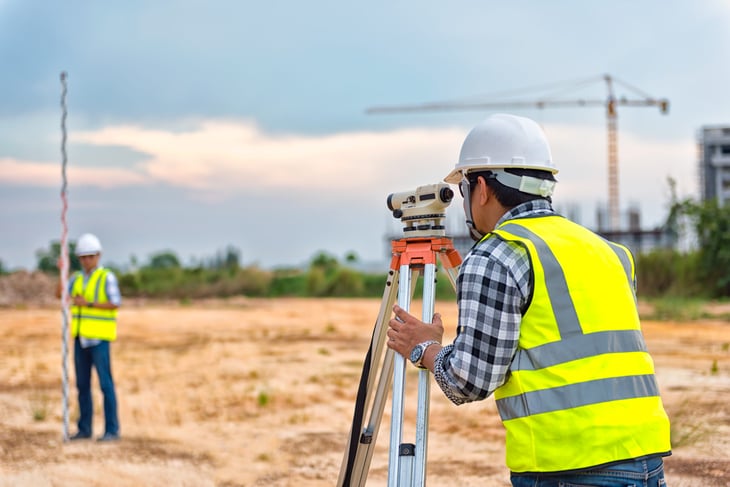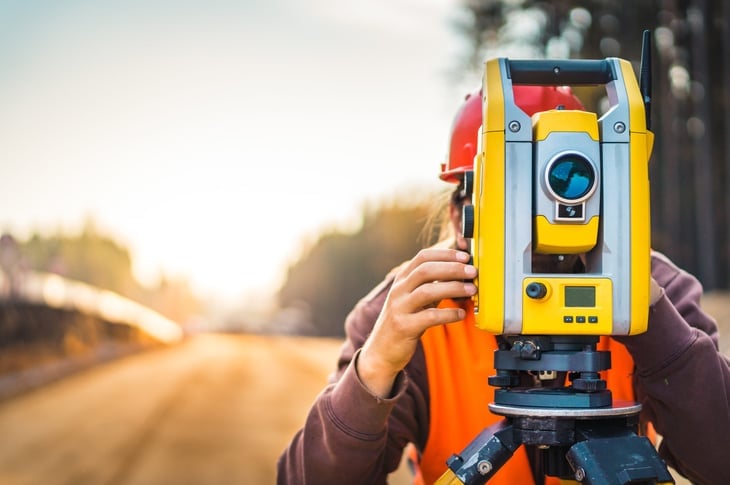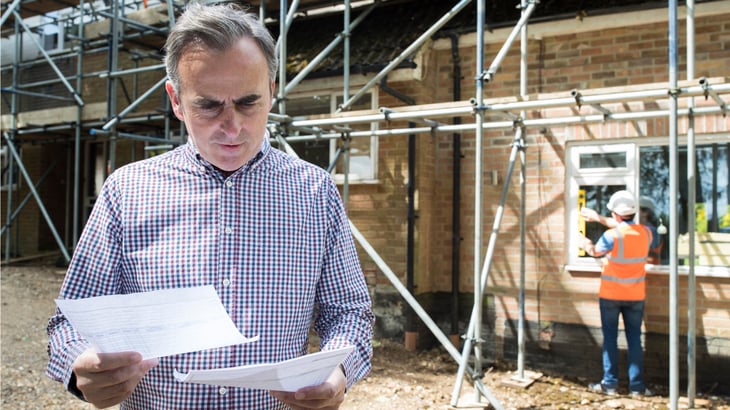
Editor's Note: This story originally appeared on Point2.
Whether you’re buying or selling a house or simply dreaming of self-building your dream home, you might have come across the term land survey. But what exactly is a land survey, and what do you need it for?
Land surveys come in various shapes and sizes, with complicated jargon that can easily trip you up if you’re not careful. Plus, different types of surveys have different costs.
So, getting it wrong could cost you valuable time and money. Let’s take a deeper look.
What Is Land Surveying?

A land survey, also known as a property survey in some areas, is designed to help you, as a landowner or potential landowner, better understand the boundaries and layout of a parcel of land.
A land surveyor will provide a documented report and drawing/map that details the exact measurements, shape and boundaries of a particular piece of land, as well as any physical features to be aware of.
Depending on the type of land survey you have conducted, the report will include different measurements and elements.
You can typically expect it to record your plot’s boundaries, shape and elevation at a minimum.
Who Needs Land Surveying?

Land surveys can be helpful for a wide range of people. For the most part, homeowners, buyers and sellers are most likely to require a land survey, and there are several instances in which they’re needed:
- Selling real estate: The seller may take out a land survey to let buyers know exactly what they’re purchasing, especially in rural areas.
- Buying real estate: In the same vein, buyers purchasing land may also request that a land survey be taken out to verify the details given by the seller.
- Neighbor disputes: Homeowners with boundary issues can use a land survey to solve the problem.
- Utility installation and new construction: Homeowners, self-builders or buyers may take out a land survey if they plan to install new utilities, such as a septic system, or build a new outbuilding or extension. This ensures the new installment falls entirely within the boundaries and isn’t too close to any boundary lines. In some areas, certain types of buildings can’t be too close to the boundaries — if they are, they must meet a different set of codes.
- Dividing land: A landowner who plans to split their lot into several smaller plots will be required to take out a land survey.
- Mortgage obligations: With some types of mortgage, the lender will require the borrower to carry out a land survey on the property or lot. The survey basically lets them know where their money is going and whether it’s a safe investment.
In most cases, a land survey must be conducted by a professional land surveyor to be legal. For example, a mortgage lender wouldn’t accept a land survey from anyone other than a certified land surveyor.
Are Land Surveys Optional?

In many parts of Canada and the U.S., land surveys are required by law in multiple circumstances. These include buying or selling land or property and building a new house, outbuilding or extension.
In the latter case, the land survey is required to ensure the correct permits and approvals are obtained before any work is carried out.
How Is a Land Survey Carried Out?

Once you’ve booked a land surveyor, there are three main steps that they’ll need to go through before they can deliver the finished report.
First, they’ll spend a few days carrying out essential research. During this time, they’ll obtain information regarding the boundaries from local government bodies.
Next, they’ll visit the property or land to collect the necessary data to compile their report. Depending on the type of survey and the size of your lot, this can take anywhere from a couple of hours to several days.
Finally, the data that’s been collected is written up into a detailed report, and a land survey map is drawn up.
Different Types of Land Surveys

As mentioned, there are several different types of land surveys that you can take out. Each serves a different purpose, with some being more in-depth than others.
1. Boundary Survey

Also known as a property line survey, a boundary survey is one of the most basic types of land survey. It’s also among the most common and is typically used:
- To resolve boundary disputes
- Before installing new utilities or building extensions
- Before buying or selling property or land
A boundary survey measures distance and marks out the property lines of a parcel of land. Boundary surveys don’t usually take too long, especially compared with more complicated ones.
2. ALTA Survey (U.S. Only)

An American Land Title Association (ALTA) survey is only relevant in the U.S. However, Canada has similar equivalents, namely the Surveyor’s Real Property Report (SRPR).
In any case, be sure to check the local requirements first and foremost.
Lenders and title companies typically require an ALTA survey to issue an ALTA title insurance policy. As such, this type of survey is usually required by buyers and investors who are about to purchase a new home or parcel of land.
Similar to a boundary survey, an ALTA survey documents the current boundaries and any easements and public rights of way.
3. Topographic Survey

A topographic survey offers a more in-depth look at a parcel of land. It details the locations and measurements of all natural and man-made features, such as trees, buildings, roads, rivers and utilities.
It’s commonly required by architects, engineers, and home builders who work on new constructions or property improvements.
4. Other Types of Land Surveys

Other types of land surveys include:
- Mortgage surveys: Similar to an ALTA survey and required by certain lenders to verify boundaries, structures, zoning codes and title owners.
- New construction surveys: Utilizing horizontal and vertical grading, this survey is required before any new construction can begin.
- As-built survey: Provides highly accurate blueprints of your home’s interior and exterior plans using lasers to create a 3D rendering of the building.
- Subdivision survey: Required by law to record the new lots created when a landowner wishes to split their land into smaller parcels.
How Much Does a Land Survey Cost?

When asking “How much is a land survey?”, it’s worth remembering that no glove fits all. For example, the property line survey cost will differ drastically depending on the size of the lot.
And while it’s generally among the most affordable types of land survey, it can be more expensive than a topographic survey on a smaller lot. Location will also make a difference.
However, as a general rule of thumb, you can typically expect a land survey to cost between $400 and $1,200.





Add a Comment
Our Policy: We welcome relevant and respectful comments in order to foster healthy and informative discussions. All other comments may be removed. Comments with links are automatically held for moderation.